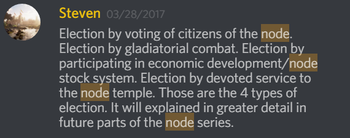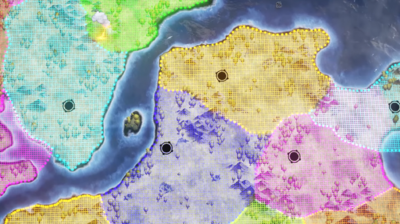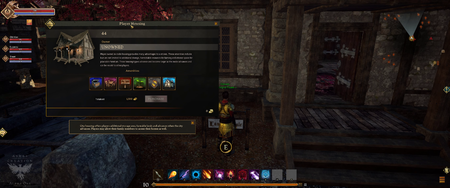Nodes
Encompassing each server are carefully placed points of development called Nodes. Every node is given purview over a predefined zone of influence (ZOI).[2]
Node advancement
Player activity (questing, gathering, raiding, etc.) within a Node's ZOI counts toward that particular Node’s advancement. There are six stages of node advancement.[2]
- Expedition (Few hours)
- Encampment (Many hours)
- Village (Few days)
- Town (Many days)
- City (Few weeks)
- Metropolis (Many weeks)
The advancement of a node unlocks its unique content, which comes at the cost of locking out an increasing ring of neighboring nodes from progressing to the next stage.[3]
Node development
Nodes have a base style template based on race and the Node type.[4] The node's government will decide the types of buildings to be constructed.[5]
- Apartment complexes
- Merchant housing
- Guild halls
- Marketplaces
- Barracks
When the building types are determined, the community will then need to come together to build them. Different governments may change the buildings within a node.[4]
Node government
A node's government and its mayor are chosen depending on the Node type.[6]
- Divine node governments are chosen from citizens via service oriented quests that prove faith and dedication to the node.
- Economic node governments are able to be bought and sold by citizens with the most money.
- Military node governments are chosen from citizens through last man standing combat.
- Scientific node governments are elected democratically.
Guilds do not control nodes.[7]
Node housing
Static housing provides non-instanced player accommodation within a node, also known as in-node housing.[9]
- Players are able to purchase small one room houses (cottages) starting at the Village (stage 3).[9][10]
- There will be 8 cottages available for purchase at the village stage.[10]
- The amount of static housing increases as a normal part of node advancement.[11]
- The architecture of static housing is predetermined by the racial influence of the node's layout and style.[12]
- Taverns and Player shops are not tied to in-node housing.[13]
Notes
- ↑ Node series part I]
- ↑ 2.0 2.1 A reactive world - Nodes
- ↑ Ashes of Creation - Nodes part 2
- ↑ 4.0 4.1 350px
- ↑ Ashes of Creation livestream Q&A, 19 May 2017 (33:56)
- ↑

- ↑

- ↑ Video, May 31, 2020 (38:50).
- ↑ 9.0 9.1 Node series part II – the Metropolis.
- ↑ 10.0 10.1

- ↑ Steven Sharif - Clarification points from today’s stream.
- ↑ Livestream, May 19, 2017 (33:57).
- ↑ Interview, July 8, 2020 (33:34).

